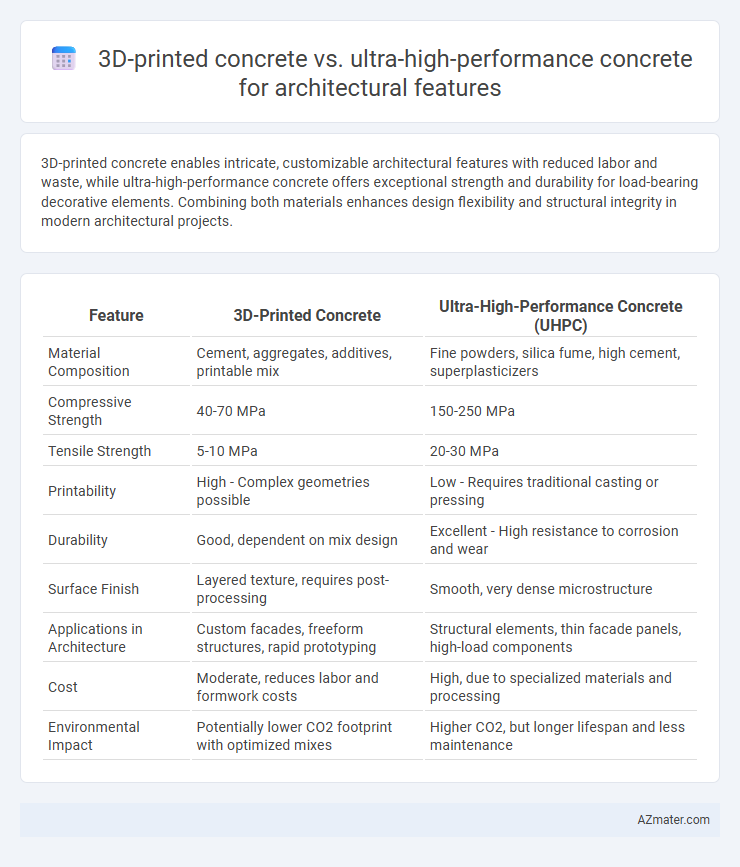3D-printed concrete enables intricate, customizable architectural features with reduced labor and waste, while ultra-high-performance concrete offers exceptional strength and durability for load-bearing decorative elements. Combining both materials enhances design flexibility and structural integrity in modern architectural projects.
Table of Comparison
| Feature | 3D-Printed Concrete | Ultra-High-Performance Concrete (UHPC) |
|---|---|---|
| Material Composition | Cement, aggregates, additives, printable mix | Fine powders, silica fume, high cement, superplasticizers |
| Compressive Strength | 40-70 MPa | 150-250 MPa |
| Tensile Strength | 5-10 MPa | 20-30 MPa |
| Printability | High - Complex geometries possible | Low - Requires traditional casting or pressing |
| Durability | Good, dependent on mix design | Excellent - High resistance to corrosion and wear |
| Surface Finish | Layered texture, requires post-processing | Smooth, very dense microstructure |
| Applications in Architecture | Custom facades, freeform structures, rapid prototyping | Structural elements, thin facade panels, high-load components |
| Cost | Moderate, reduces labor and formwork costs | High, due to specialized materials and processing |
| Environmental Impact | Potentially lower CO2 footprint with optimized mixes | Higher CO2, but longer lifespan and less maintenance |
Introduction to Modern Concrete Technologies
3D-printed concrete revolutionizes architectural features by enabling complex geometries and customized designs with minimal material waste and faster construction times. Ultra-high-performance concrete (UHPC) offers exceptional strength, durability, and aesthetic versatility, making it ideal for intricate facades and thin, load-bearing elements. Both technologies represent cutting-edge advancements in modern concrete, enhancing structural performance and design possibilities in contemporary architecture.
What is 3D-Printed Concrete?
3D-printed concrete is an innovative construction material extruded layer-by-layer using automated robotic systems, allowing for complex shapes and customized architectural features with minimal formwork. It offers high design freedom and rapid on-site fabrication, ideal for creating intricate facades and sculptural elements that traditional casting methods struggle to achieve. Compared to ultra-high-performance concrete (UHPC), which prioritizes extreme strength and durability, 3D-printed concrete emphasizes geometric complexity and construction efficiency in architectural applications.
Defining Ultra-High-Performance Concrete (UHPC)
Ultra-High-Performance Concrete (UHPC) is a cementitious material characterized by superior strength, durability, and ductility, achieved through a dense microstructure created by fine powders, fibers, and optimized particle packing. Compared to 3D-printed concrete, UHPC offers enhanced mechanical properties and reduced porosity, making it ideal for intricate architectural features requiring high load-bearing capacity and longevity. Its ability to be cast into thin, complex shapes with a smooth finish supports innovative architectural designs while ensuring resilience against environmental stressors.
Architectural Flexibility: Design Freedom Compared
3D-printed concrete enables unparalleled architectural flexibility by allowing complex geometries and organic forms without the constraints of traditional molds or formworks, significantly expanding design possibilities. Ultra-high-performance concrete (UHPC) offers exceptional strength and durability, permitting slender, intricate structural elements but requires more conventional shaping methods that limit complex freeform creativity. The combination of 3D printing technology with UHPC materials is rapidly advancing, enhancing both design freedom and structural performance for innovative architectural features.
Structural Performance and Durability
3D-printed concrete offers enhanced design flexibility and complex geometries with comparable structural performance suitable for lightweight architectural features, while ultra-high-performance concrete (UHPC) provides superior compressive strength exceeding 150 MPa and exceptional durability, including high resistance to chloride penetration and freeze-thaw cycles. UHPC's dense microstructure ensures long-term durability and minimal maintenance, making it ideal for highly stressed architectural components requiring longevity. The choice depends on balancing innovative form freedom of 3D printing against the proven mechanical robustness and durability of UHPC for structural applications.
Surface Finish and Aesthetic Potential
3D-printed concrete offers exceptional flexibility in creating complex, customized architectural features with intricate surface textures directly from digital designs, enabling innovative aesthetic possibilities hardly achievable with traditional methods. Ultra-high-performance concrete (UHPC) provides superior smoothness, high density, and refined finishes that enhance visual appeal and durability, making it ideal for sleek, minimalist architectural surfaces. While 3D-printed concrete excels in design complexity and form freedom, UHPC dominates in achieving polished, high-strength finishes for premium architectural aesthetics.
Sustainability and Environmental Impact
3D-printed concrete minimizes material waste and reduces energy consumption during construction compared to traditional methods, enhancing sustainability in architectural features. Ultra-high-performance concrete (UHPC) offers exceptional durability and longevity, decreasing the need for frequent repairs and associated environmental costs. Both materials contribute to eco-friendly building practices, but 3D-printed concrete has a distinct advantage in reducing carbon footprint through efficient material use and faster project completion.
Cost Considerations and Resource Efficiency
3D-printed concrete reduces labor and formwork expenses through automated layering, offering cost savings for complex architectural features, while ultra-high-performance concrete (UHPC) demands higher material costs but provides superior strength and durability, decreasing long-term maintenance expenses. Resource efficiency in 3D printing is optimized by minimizing waste with precise material deposition, contrasting with UHPC's high cement content and energy-intensive production that impact sustainability. Evaluating project scale and design complexity guides the choice, where 3D-printed concrete excels in customization and rapid construction, and UHPC ensures longevity and structural performance.
Real-World Applications and Case Studies
3D-printed concrete enables intricate, custom architectural features with reduced material waste and faster construction, demonstrated in projects like the Eindhoven 3D-printed bridge and architectural facades in Dubai's Office of the Future. Ultra-high-performance concrete (UHPC) offers exceptional compressive strength and durability, used in landmark structures such as the Zaha Hadid-designed Leeza SOHO Tower in Beijing and the Port Authority Bus Terminal expansion in New York City. Case studies highlight 3D-printed concrete's advantage in complex geometries and UHPC's superior performance under structural loads and harsh environmental conditions.
Future Prospects in Architectural Features
3D-printed concrete offers unprecedented design flexibility, enabling the creation of complex, customized architectural features that push the boundaries of traditional construction methods. Ultra-high-performance concrete (UHPC) provides exceptional strength and durability for sleek, minimalist designs with enhanced longevity in architectural applications. Future prospects include combining 3D printing technology with UHPC's superior material properties to achieve innovative, sustainable structures with optimized aesthetics and performance.

Infographic: 3D-printed concrete vs Ultra-high-performance concrete for Architectural feature
 azmater.com
azmater.com